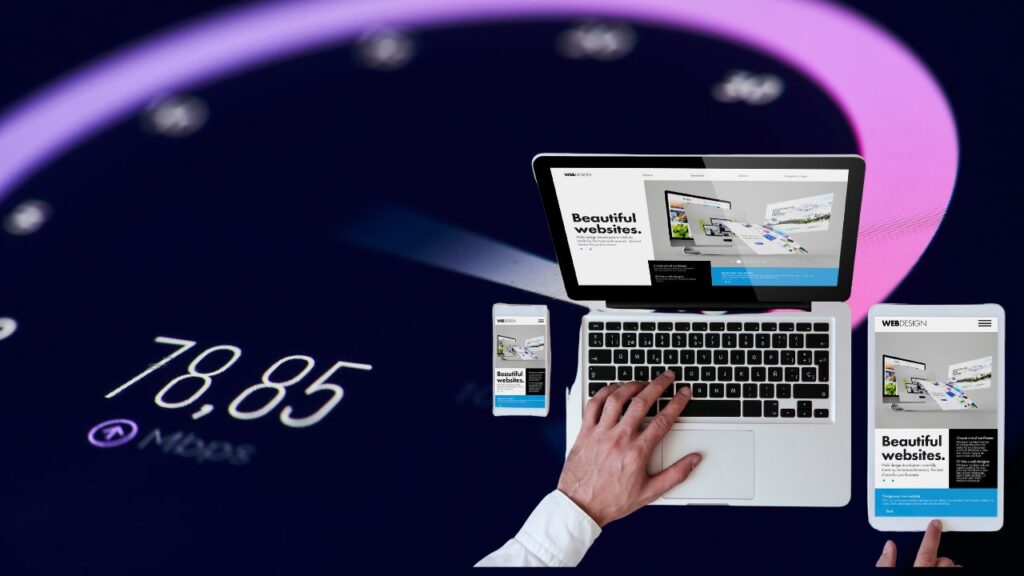Welcome to our guide on making your website faster and more user-friendly. A fast and easy-to-use website keeps visitors happy and helps your site succeed. Whether you’re new to website management or have been doing it for a while, these tips will help you improve your site right away. Learn how to super charge your website speed with some great tips. Read on and find out.
1. Understanding Website Speed and User Experience

What is Website Speed?
Website speed is how quickly your web pages load when someone visits your site. If your website loads quickly, visitors are more likely to stay and look around. If it’s slow, they might leave before they see what you have to offer. Want to find out your website speed? Try this
Why Website Speed Matters?
- User Satisfaction: People like fast websites. If your site takes too long to load, visitors will get frustrated and leave.
- Search Engine Ranking: Google and other search engines rank fast websites higher in search results. This means more people can find your site.
- Conversion Rates: Faster websites often lead to more sales and sign-ups because visitors are more likely to stay and interact with your site.
What is User Experience (UX)?
User Experience, or UX, is about how visitors feel when they use your website. A good UX means the site is easy to use, looks nice, and provides value to the visitor.
Why UX Matters
- Visitor Retention: A great UX makes visitors want to come back.
- Brand Reputation: A positive UX can make your brand look more professional and trustworthy.
- Business Goals: Good UX helps you achieve your goals, whether it’s selling products, getting sign-ups, or sharing information.
2. Tips to Improve Website Speed

Choose a Good Hosting Provider To have Good Website Speed
Your hosting provider is where your website lives on the internet. A good provider ensures your site loads quickly and stays online.
- Look for Speed: Choose a provider known for fast loading times.
- Check Uptime: Make sure they have a good track record of keeping sites online.
- Customer Support: Good support can help you fix problems quickly.
Optimize Images To Improve Website Speed
Images can slow down your website if they are too large. Optimizing images makes them load faster.
- Use the Right Format: JPEGs are good for photos, PNGs for graphics with fewer colors.
- Compress Images: Use tools like TinyPNG or JPEG-Optimizer to reduce image size without losing quality.
- Responsive Images: Use images that adjust to different screen sizes, so they load quickly on all devices.
Enable Browser Caching To Improve Website Speed
Caching stores some of your website’s data on visitors’ computers. This makes your site load faster when they visit again.
- Set Expiry Dates: Tell browsers how long to store your files. This reduces the need to download them again.
- Use Plugins: If you use WordPress, plugins like W3 Total Cache can help with caching.
Minimize HTTP Requests To Improve Website Speed
Each part of your website (like images, scripts, and stylesheets) needs an HTTP request to load. Fewer requests mean faster loading times.
- Combine Files: Put your CSS and JavaScript into single files.
- Use CSS Sprites: Combine multiple images into one file. This reduces the number of requests.
- Reduce Plugins: Only use essential plugins to avoid unnecessary requests.
Use a Content Delivery Network (CDN) To Improve Website Speed
A CDN is a network of servers around the world. It stores copies of your website and delivers them from the server closest to the visitor.
- Faster Delivery: CDNs reduce the distance data has to travel, speeding up load times.
- Reliability: CDNs can handle more traffic and keep your site online even during high traffic times.
Optimize CSS and JavaScript To Improve Website Speed
Your site’s styles and scripts can slow it down if they are not optimized.
- Minify Code: Remove unnecessary characters from your CSS and JavaScript files. Tools like UglifyJS and CSSNano can help.
- Defer Loading: Make non-essential scripts load after the main content.
- Inline Critical CSS: Put important CSS directly in the HTML to load it faster.
Enable Compression
Compressing your website’s files can make them smaller and faster to load.
- Use Gzip: Gzip compression reduces file sizes. Most web servers support it, and it can significantly improve load times.
- Check Compression: Tools like Gtmetrix can check if your site is using compression properly.
3. Tips to Improve User Experience (UX)
Easy navigation helps visitors find what they need quickly.
- Clear Menus: Use simple, clear labels for your menu items.
- Consistent Layout: Keep the navigation in the same place on all pages.
- Search Bar: Include a search bar so visitors can find things quickly.
Use a Mobile-Friendly Design
More people are using mobile devices to browse the web. Your site needs to look good and work well on phones and tablets.
- Responsive Design: Use a design that adjusts to different screen sizes.
- Touch-Friendly: Make buttons and links big enough to tap easily.
- Fast Loading: Mobile users expect fast load times. Make sure your site is optimized for speed.
Improve Readability
Make sure your content is easy to read and understand.
- Use Headings: Break up text with headings to make it easier to scan.
- Short Paragraphs: Keep paragraphs short and to the point.
- Readable Fonts: Use fonts that are easy to read and a good size (at least 16px).
Use High-Quality Content
Content is king. High-quality content keeps visitors engaged and coming back.
- Valuable Information: Provide useful and relevant information.
- Engaging Media: Use images, videos, and infographics to make content more interesting.
- Regular Updates: Keep your content fresh and updated.
Improve Call to Action (CTA) Buttons
CTAs guide visitors to take the next step, like signing up or making a purchase.
- Clear Text: Use action words like “Sign Up Now” or “Get Started”.
- Visible Placement: Place CTAs where they are easy to see.
- Contrasting Colors: Use colors that stand out from the rest of the page.
Ensure Accessibility
Make your site usable for everyone, including people with disabilities.
- Alt Text for Images: Describe images for visitors who use screen readers.
- Keyboard Navigation: Ensure your site can be navigated using a keyboard.
- Contrast Ratio: Use high-contrast colors to make text easier to read.
Fast Loading Time
A fast site improves UX by reducing waiting times.
- Follow Speed Tips: Use the tips from the speed section to keep your site fast.
- Regular Testing: Use tools like Google PageSpeed Insights to check your site’s speed regularly.
4. Regular Maintenance and Testing
Regular Updates
Keep your website software up to date. This includes your content management system (CMS), plugins, and themes.
- Security: Updates often include security patches.
- Performance: New versions can be faster and more efficient.
- Features: Updates can include new features that improve UX.
Monitor Performance
Keep an eye on how your website is performing.
- Analytics Tools: Use tools like Google Analytics to track visitor behavior and site performance.
- Speed Tests: Regularly test your site’s speed with tools like Gtmetrix or Pingdom.
- Error Logs: Check error logs to find and fix issues.
Backup Your Site
Regular backups protect your data in case something goes wrong.
- Automatic Backups: Use a service or plugin that automatically backs up your site.
- Store Backups Off-Site: Keep backups in a different location to avoid losing them if your main site is compromised.
Test Changes
Before making big changes to your site, test them to make sure they work well.
- Staging Site: Use a staging site to test changes without affecting your live site.
- User Testing: Get feedback from real users to see how changes affect UX.
Analyze User Feedback
Listen to your visitors to improve your site.
- Surveys: Use surveys to ask visitors about their experience.
- Comments: Pay attention to comments and suggestions from visitors.
- Analytics: Use data to see where visitors are having trouble and make improvements.
Conclusion
Improving your website’s speed and user experience is essential for keeping visitors happy and achieving your goals. By following these tips, you can make your site faster, easier to use, and more successful. Remember to keep testing and updating your site to ensure it stays in top shape. for
Summary
- Website Speed: Choose a good hosting provider, optimize images, enable browser caching, minimize HTTP requests, use a CDN, optimize CSS and JavaScript, and enable compression.
- User Experience: Simplify navigation, use a mobile-friendly design, improve readability, use high-quality content, improve CTA buttons, ensure accessibility, and maintain fast loading times.
- Regular Maintenance: Regular updates, monitor performance, backup your site, test changes, and analyze user feedback.
By implementing these strategies, you can instantly supercharge your website, enhancing both speed and user experience for your visitors. For more great articles read other articles on marginseyedigital.com and do not forget to contact us with help to speed up your website. You can also READ this insightful from one of our EXPERTS and learn why website speed matters.


One Response